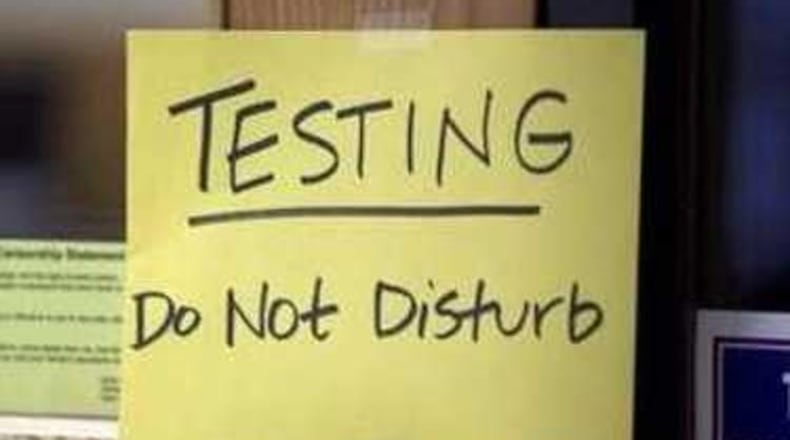In Dayton Public Schools, the results could determine whether the district faces state takeover this fall, although legislators have vowed changes to that system, leaving DPS in limbo.
RELATED: State school board finalizes long-term graduation proposal
In recent years, districts ranging from Oakwood to West Carrollton to Dayton have questioned the validity of the state tests, on issues from alignment with content standards as well as grading and cut scores. Some state tests have been eliminated, and State Superintendent Paolo DeMaria recommended cutting more.
But the Dayton-based Fordham Institute on education has argued that standardized tests are crucial, giving an objective view of academic performance and holding schools accountable.
Mad River Schools Superintendent Chad Wyen said this week that he considered the previous plan of tying a diploma to certain standardized tests “a disservice to our students” and “educational malpractice.”
“It is nice that we are finally moving toward a blended and more equitable model of requirements for graduation with a greater focus on the whole child rather than simply relying on test scores to determine what it means to be a high school graduate in the state of Ohio,” Wyen said.
RELATED: Bipartisan group seeks new school funding plan for Ohio
Kettering Assistant Superintendent Dan Von Handorf said that “whole child” approach might eventually lessen the testing stress that some students face. But he said given long-term uncertainty over graduation policy and the role of state tests, schools are taking the next month seriously as usual.
“(Teachers) have been working really hard to make sure our kids are highly successful on those tests,” Von Handorf said.
Miamisburg Director of Secondary Education Stacie Moore agreed, saying that helping students get 18 points on state tests “remains our No. 1 goal” toward graduation.
How much testing do students get?
Each district chooses a span of 15 school days between March 25 and April 26 to give the state English tests, and another 15-day window between April 1 and May 10 for the math, science and social studies tests.
Students in grades three, four, six and seven take an English test and a math test, a total of five to seven hours of testing spread over multiple days. Grades five and eight test in English, math and science, for a total of eight to nine hours. The elementary-level social studies tests were eliminated two years ago.
RELATED: How did local schools fare on the state report card?
High school students take seven end-of-course exams — in English I, English 2, algebra, geometry, biology, American history and American government. They take the tests in the year they take each of those classes, with an average freshman or sophomore often taking three tests per year, for a total of nine to 10 hours of testing over multiple days.
Each test is supposed to be aligned to the academic content standards for that grade and subject.
When districts take the tests
Spring break is one hiccup in test scheduling, as 23 of the 40 Dayton-area districts are off this week, and another six are off next week. Some, including Dayton, will jump into testing quickly after they return. Fairborn, which has a mid-April break, began its English testing this week and will wrap it up before break. It will then do the other subjects starting in late April.
Franklin schools Assistant Superintendent Robyn Donisi said her district gives students a few days after spring break “to get back in the groove before testing” and like many schools, will only give students one test segment on any given day “to minimize test fatigue.”
Tests are primarily given online, and each test is made up of two segments (usually 75 or 90 minutes per segment). Some schools space the tests out, while others try to get through them more quickly.
EDUCATION: More leaders criticize state takeover law for schools
In Brookville, a fifth-grader would take the two segments of their English test April 15-16, then the two parts of their math test May 1-2, and the two pieces of the science test May 6-7. Mad River also spaces some tests out, with Spinning Hills Middle School beginning English tests in mid-April, while other subject tests can go as late as May 10.
Wayne High School, on the other hand, packs all of its tests from April 1-5 and 8-10 (with time for makeup tests through the following week). Principal Jeff Berk said he believes that’s better for his high school students’ schedules.
“Sometimes it’s a little better for the students when they can say, ‘OK, this week is testing week,’ and they can get in that mode,” Berk said. “You get it done where they’re not having stressors for an entire month because they’re testing two days this week, two days that week and three days next week, and jumping back and forth.”
During Wayne’s eight testing days, only students who are testing on a given day show up at the regular 7:50 a.m., and they go right into a test segment. The non-testing students arrive on a two-hour delay as those tests are ending. For the rest of the shortened day, Berk said students attend their odd-numbered periods one day, and even periods the next day, with each given an 80-minute class period so teachers are not rushed.
“With our infrastructure for wifi access, and the state-required test proctor ratios, with our limited staff, we wouldn’t be able to operate a regular day for the rest of the students without the delays,” Berk said.
About the Author

